 Admiralty Research Laboratory - U/W viewing systems
Admiralty Research Laboratory - U/W viewing systems
 Admiralty Research Laboratory - U/W viewing systems
Admiralty Research Laboratory - U/W viewing systems
Background
In 1949 the Admiralty Photographic and Instrument Research Laboratories, known as 'April', were absorbed into the Admiralty Research Laboratory to become the Instrumentation Group - K-Group. (The exact title of April is disputed, see Note 1, below.) One research topic that received much attention by April staff was underwater still and cine photography, and a significant amount of expertise was accumulated with the aid of ex- Royal Navy divers. Ex-RNVR frog-diver, as free-swimming divers were then known, Lt H.J. 'Jimmy' Hodges became a member of staff, and the well-known ex-RNVR Lt Cdr Lionel K.P. 'Buster' Crabb was employed as a freelance diver, as required. Both divers had distinguished themselves for counter-mining activities during WWII, Jimmy Hodges for his work on underwater mine and obstacle clearance in advance of the D-Day landings, and Lionel Crabb for his underwater mine removal from ship's hulls, in particular. One young Scientific Officer, W.R. (Rosse) Stamp, working on underwater still and cine photography was very effective at re-engineering the cameras for improved reliability and quality; many of the improvements were adopted by the manufacturers, Vinten in particular - see Note 2, below. Rosse Stamp was a rare breed of Physics graduate, possessing an abundance of commonsense and skilled in mechanical and electrical / electronic engineering. As a young lad, Rosse was fortunate enough to have access to a workshop where he constructed his own cameras from scratch, including grinding his own lenses.
A considerable amount of underwater filming was undertaken by April staff and the following video clip, on YouTube, of Jimmy Hodges highlights the practical aspects to the research, in many ways; especially note the camera, and its specification, Jimmy Hodges is using, and ponder who is filming Jimmy Hodges - Buster Crabb is the most likely candidate!
~~~~~~~~~~~~~~~~~~~~~~~~~~~~~~~~~~~~~~~~~
Another project that involved Lionel Crabb was the production of a short film: as detailed in the following two frame captures:-
Lionel Crabb produced the story-line for the above film, whilst under-contract to ARL in 1950, and it features filming by Jimmy Hodges over the period 1948-49. Hence the dual credits of both the Admiralty Photographic and Instrument Research Laboratories, and the Admiralty Research Laboratory.
To conclude this introduction to underwater viewing systems, by 1951 Rosse Stamp was embarked upon an investigation into the possibilities and problems of using the medium of television for remote underwater viewing, building upon his considerable expertise in the science and engineering behind underwater still and cine photography.
The birth of rapidly deployable, portable underwater viewing systems
In 1951, although submarine related work, principally their quietening, detectability & detection, was absorbing considerable resources, ARL was more than capable of responding to urgent needs:-
Upon hearing that HM Submarine AFFRAY was missing as of 1100hrs Tuesday 17th April 1951, Lionel Crabb had offered his services as a (freelance) diver - see Note 3, below, maintaining that if the submarine was lying is less than 120ft of water, he using his frogman's gear could reach it considerably quicker than a diver equipped with the bulky standard diving outfit - the time required to position the diving vessel, and prepare and deploy a standard diver could be a critical factor in the rescue of the crew.
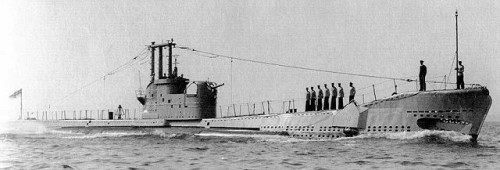
HMS/M AFFRAY was one of the AMPHION-class, a late WWII design of submarine
Approximately 36 hours after AFFRAY had first dived Lionel Crabb was aboard HMS RECLAIM, the RN Deep Diving and Submarine Rescue vessel involved in the search for the submarine.

HMS RECLAIM
However all likely seabed contacts located up to the first week in May 1951 had been in depths greater than his diving limit. For this reason Lionel Crabb returned to shore to challenge Rosse Stamp at ARL to produce a remote underwater viewing system suitable for seabed searches, employing (closed-circuit) television technology. He had in mind that a remote viewing system, being much faster to deploy than a standard diver and with unlimited endurance, would speed-up the search for AFFRAY; this was proved conclusively once ARL's hastily constructed, world's first, portable underwater viewing system had been embarked upon RECLAIM.
Following a meeting with ARL’s Superintendent Dr Nyman Levin (see Note 4), Rosse Stamp ably assisted by John (Jack) Revie and R.B. (Jock) Phillips proceeded to design and construct an underwater enclosure to house a television camera, under the Secret codename of LACQUER. The decision to classify the project was purely political, as a precaution should the concept fail; public statements having previously been made to the effect that every effort and conceivable method was already being employed to find the lost submarine.
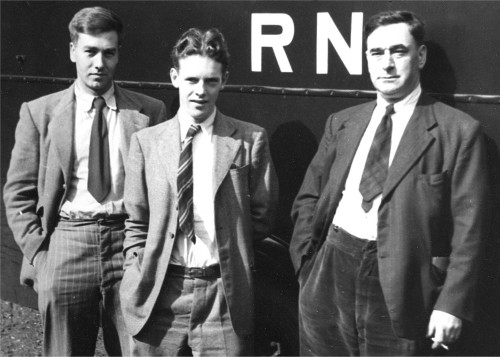
The ARL Team (from left): Rosse Stamp, Jack Revie & Jock Phillips
It was left to Rosse Stamp to promote the underwater TV concept and so convince the officer in charge of the search, Capt William (Bill) Shelford, that a system would help overcome some of the difficulties and hazards of diving in strong tidal conditions such as they were experiencing. Prevailing conditions in the English Channel, at the time of the search, made the identification of bottom contacts located by acoustic means a slow and tedious operation.
The camera used was similar to that which the BBC hired from Marconi Wireless Telegraph Company of Chelmsford for its outside broadcasts; notably the 1949 University Boat Race, where the camera and associated electronics had been carried by a small boat. For the ARL system, the camera was modified such that it could be controlled remotely over 500ft of watertight cable specially manufactured by BICC with an additional (outer) polythene sheathing to improve watertight integrity and robustness. The camera was mounted vertically with its single wide-angle lens immediately behind a thick plate-glass window in the base of the enclosure. A tubular metal frame was built and attached to the camera’s enclosure, to which a light source (1.5kW Tungsten standard diver’s lamp) was attached.

Underwater TV camera deployed (over the side) using one of
RECLAIM's
well-deck cranes.
Lionel Crabb took
charge of the camera's deployment.
Photo: W.R. Stamp collection
Whilst far from elegant the underwater assembly (nick-named The Ugly Duckling) was soundly engineered and proved more than adequate for the job. A truly remarkable achievement as the portable underwater viewing system was designed and constructed in a bare three weeks of work that included modifications to the camera's electronics for remote control.

ARL Scientific Officer Rosse Stamp and Lab Mechanic Jock Phillips
with the
underwater TV assembly on
the well-deck of RN Deep Diving &
Submarine Rescue vessel HMS RECLAIM.
Photo:
WR Stamp Collection, taken by Jack Revie using Rosse's camera
The only suitable space onboard RECLAIM for the majority of the system's electronics for processing and display of the video signal from the camera, was the captain's cabin.
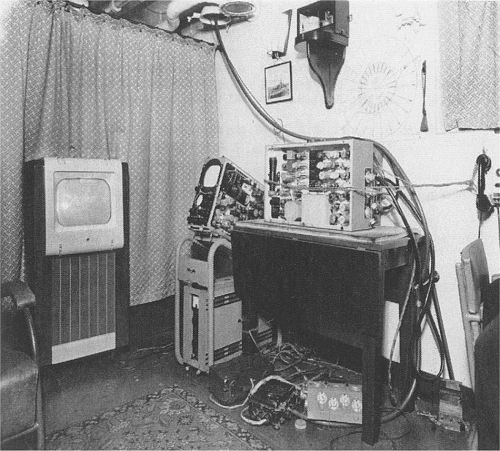
View of the TV equipment
installed onboard RECLAIM -
all part of the remote viewing system hastily fitted in May 1951 - see
Note 5
Photo: W.R. Stamp Collection
At sea, it was found that the system, deployed in a matter of minutes, provided trouble-free viewing to a distance of 15 foot, whereas deep sea diver, and diving chamber, deployment was laborious and time-consuming, and a diver's visibility was limited to some 5 feet.
With the aid of the viewing system RECLAIM had completely re-searched the originally defined search area by the end of May, and commenced searching a newly defined area to the south of the track assumed to have been taken by AFFRAY. On the 12th June, some twelve days later, the Frigate HMS LOCH INSH (a member of the search force) made sonar contact with a large object on the seabed. This object had failed to be detected on two separate occasions that the area had previously been searched, on the 17th and 18th April 1951. The fact that the large contact was missed by the UK and US ships of the original search force and detected by LOCH INSH may be attributed to the combined operation of the frigate's main sonar (type 170) and side-looking sonar type 162 that resulted in the (sonar) Range Recorder displaying a cigar-shaped object on the seabed - a concept proposed by ARL. This was the first sonar contact (detected) of similar size and shape to AFFRAY, in the two months of searching for the submarine.
A deployment of RECLAIM's diving chamber containing three divers established that the object found was in all probability AFFRAY, being free of marine-growth. Despite the water depth being almost 100 feet deeper than the design-depth of 200 feet, Lionel Crabb took a calculated risk and deployed the underwater camera. There followed, in rapid succession, two quirks of fate. Firstly, the camera just happened to be lowered directly over the Fin (Conning Tower) of the submarine, and instantly it was possible to surmise that it had been operating at periscope depth when disaster had stuck. Secondly, the camera moved (under the effect of the strong tidal flow) such that the submarine's nameplate (on the side of the Fin) could be easily read; thus establishing irrefutably the final resting place of AFFRAY.

Photo of TV screen displaying the view of AFFRAY's nameplate of the side of
the fin.
Photo: WR Stamp Collection
The underwater remote viewing system continued to be of use as an aid to the positioning of divers for best effect whilst they conducted their lengthy investigation of the sunken submarine, at a depth of some 280-ft.

Photo of TV screen displaying the view of AFFRAY's sheared Snort Mast
Photo: W.R. Stamp collection
~~~~~~~~~~~~~~~~~~~~~~~~~~~~~~~~~~~~~~~~~
Following the search for AFFRAY, a minor equipment requirement was raised for a permanent remote viewing system for RECLAIM, and PYE Ltd of Cambridge was awarded (on the basis of cost) the contract to supply the equipment, much to the disappointment of the Marconi Company who had hoped they would be selected on the basis of their supply of the original television equipment.

Rosse Stamp (second from left) providing technical support to PYE
at a presentation
(possibly to the RN)
of their version of the original underwater television,
manufactured for use
aboard RECLAIM
Photo: W.R. Stamp collection
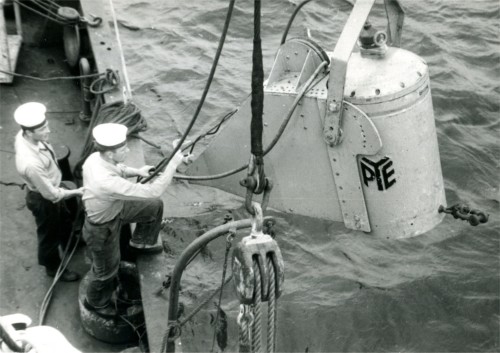
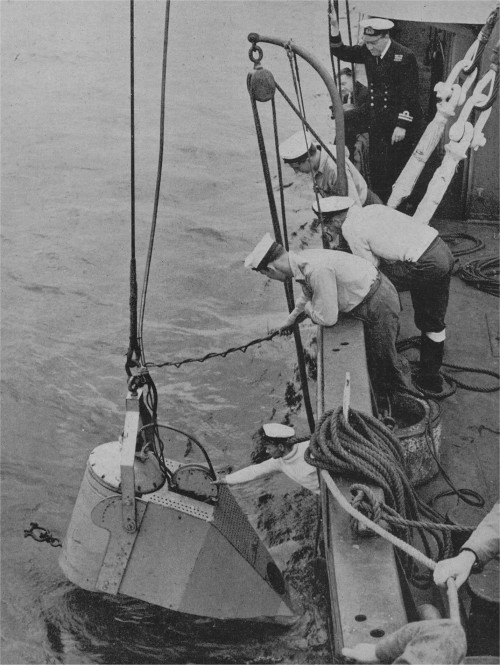
Despite the CCTV camera being awkward to deploy, the benefits were enormous!
Photos: W.R. Stamp collection
Video clip on YouTube of the purpose-built CCTV system in use on RECLAIM, to
ARL's design
~~~~~~~~~~~~~~~~~~~~~~~~~~~~~~~~~~~~~~~~~
The success achieved by underwater television as applied to the search for AFFRAY opened up the field for further developments. Underwater casings were built to carry-out trials, in the first instance, to ascertain the performance of television with particular reference to its application to mine countermeasures (MCM) in UK coastal waters. During these experiments which were carried out aboard HMS WELFARE, the relationship was established between water turbidity as measured by the hydrophotometer and the range of vision of the underwater camera. Around this time Rosse Stamp was invited to take part in a BBC Home Service programme "Science Survey" - click hear to listen to a recording, broadcast at 10.30 p.m. on 23rd May 1952.
Later a casing was designed and built for operation at a depth of 1000 feet. An investigation was carried out with this equipment aboard RRS DISCOVERY II in co-operation with the National Institute of Oceanography (the new name for ARL's Wave Group).
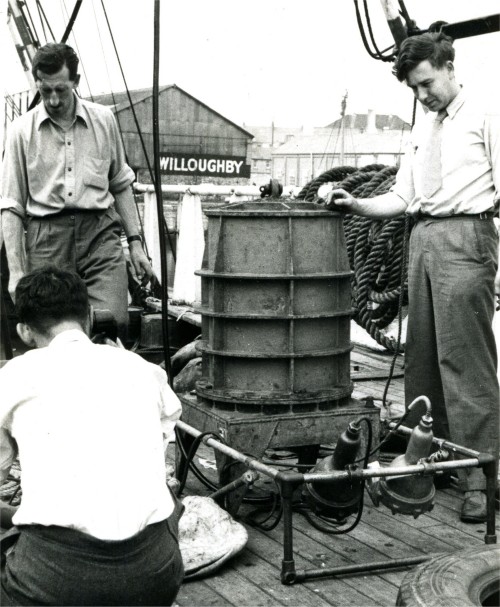
New team member George Macneice (left) with Rosse Stamp (right) and another,
readying the camera on the deck of RRS DISCOVERY II
Photo: W.R. Stamp collection
The aim of this trial was to explore the uses of underwater television for oceanographical and marine biological research, also to evaluate the problems of working at greater depths.
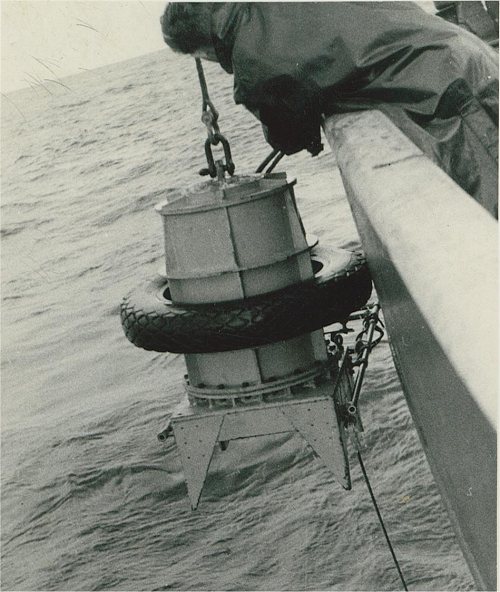
The ARL designed version for deep water deployment also used PYE
television equipment.
Photo: W.R. Stamp collection
~~~~~~~~~~~~~~~~~~~~~~~~~~~~~~~~~~~~~~~~~
The first television camera to be designed specifically for underwater use was completed in July 1953. Once again PYE Ltd was the chosen manufacturer:-
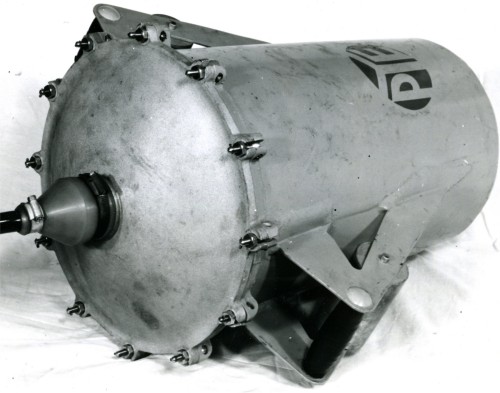

Two views of the first TV camera designed by ARL and built by
PYE, for underwater use
Photos: W.R. Stamp collection
Constructed in a compact cylindrical form round an Image Orthicon tube, it fitted into a pressure-tight case measuring only 10" diameter by 21" long and weighed less than 1 cwt in air. Another even smaller underwater camera, containing the much less sensitive but simpler "Vidicon" type tube, had been completed by 1954. Its casing, which measured 8" dia by 16" long, was designed to be hand-held by a diver.
~~~~~~~~~~~~~~~~~~~~~~~~~~~~~~~~~~~~~~~~~
ARL also conducted experiments into the use of CCTV for stereoscopic viewing using slightly modified versions of the original camera enclosure:-
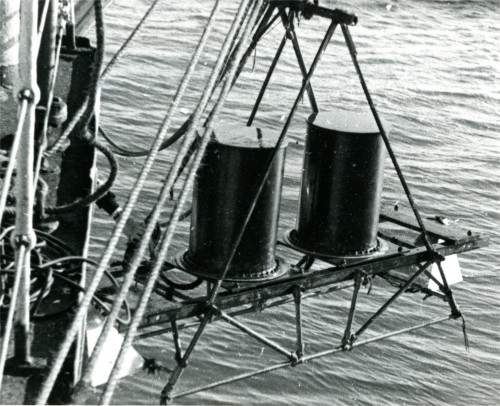
A purely experimental stereoscoptic viewing system constructed by ARL utilising two TV cameras
~~~~~~~~~~~~~~~~~~~~~~~~~~~~~~~~~~~~~~~~~
In January 1954, at the time of the de Havilland Comet G-ALYP (Yoke Peter) crash in the Tyrrhenian sea off the Island of Elba. ARL was officially called upon to provide underwater CCTV to aid the search. ARL's George Macneice was flown out and operated the CCTV to great effect, at depths between 400 and 600 ft, embarked upon RFA SEA SALVOR.
|
|
|
|
(Click on the above photos for video clips on the British Pathé site) |
|
Over eleven weeks of searching, a remarkable amount of the aircraft was recovered and re-assembled by a crash investigation team at the Royal Aircraft Establishment Farnborough. (Click here for more info and photo of the (partial) reconstruction of G-ALYP at RAE Farnborough, on the RAF Museum site.)
~~~~~~~~~~~~~~~~~~~~~~~~~~~~~~~~~~~~~~~~~
The underwater viewing research and development by ARL's Instruments Group addressed various subsidiary problems. Clear water containers to extend the camera's range of vision in very dirty water were investigated out of which the "Diver's Clear Vision Viewer" was evolved.
By 1954 ARL work on underwater viewing systems was run-down in favour of (a return to) design and development of higher-resolution underwater photography and cine-photography techniques to support ARL's Fluid Dynamics Group work.
~~~~~~~~~~~~~~~~~~~~~~~~~~~~~~~~~~~~~~~~~
Notes
1.
Past staff of the Admiralty Photographic and Instrument Research Laboratories
have stated the establishment's name as:-
(a) Admiralty Photographic and Instrument Research Laboratory, and
(b) Admiralty Photographic and Instrumentation Research Laboratory.
Whilst (a) arises from following the style of ARL's name, (b) is unlikely as the use of the word 'Instrumentation' was uncommon when April was founded in 1946. Return
2. Jimmy Hodges resigned from the Admiralty Research Laboratory in late-1951 to pursue a career in commercial underwater cine-photography:-

The camera Jimmy is holding is called the 'Vinten-Hodges' that no doubt owes
a
considerable amount to the work at April by Rosse Stamp Return
3. Both Lionel Crabb and Jimmy Hodges, in peace-time, were incredibly
courageous:-
(a) Their photographing of underway warship propeller cavitation, and torpedo
discharges from a submarine were of much benefit to ARL's research.
(b) On 12th January 1950 HM Submarine TRUCULENT (P315) sank following collision
with MV Divina in the Medway Estuary. All but 10 souls attempted escape,
prematurely. Conditions in the Estuary were abysmal, freezing cold and strong
tidal flow, which caused 57 souls that weren't picked-up by MV Divana and MV
Almdijk, to be widely dispersed and perish. Royal Navy trained frog-divers Jimmy
Hodges and Lionel Crabb, having selflessly volunteered their services,
free-dived under extremely hazardous conditions to make the first successful
attempts to reach the submarine. Return
4. In his book Alan Gallop (see below) states that Dr Nyman Levin was Superintendent of ARL. This may not be correct. Dr Levin may have been the Group Leader of the Instrumentation Group, and H.F. Willis the Superintendent. Return
5.
Fuller details on the television equipment used for
the prototype underwater viewing system may be found on the
Virtual Museum of the Broadcast TV Camera website:
www.tvcameramuseum.org Note
this site also has information on the PYE Ltd system which was used in
the search for the lost Comet aircraft in 1954. Return
~~~~~~~~~~~~~~~~~~~~~~~~~~~~~~~~~~~~~~~~~ Acknowledgements 1. The above
account of the ARL involvement in the search for the AFFRAY, and
April's and ARL's related research would have been far from complete without the information and photographs retained
by Rosse Stamp and provided by the late Gavin Stamp and Jacqueline
Riley, Rosse's nephew and niece. Note Rosse's papers and photographs
have been donated to the RN Submarine Museum, Gosport.
2. Alan
Gallop's book "SUBSMASH The Mysterious Disappearance of HM Submarine
AFFRAY" has proved to be a convenient source for some of the
non-technical details, being a well-researched account of the major
events surrounding the last UK submarine to be lost. Note there has been
a reprint of the book following communication between Rosse Stamp and
Alan Gallop; this later version is particularly recommended.
I had the privilege to work for Rosse, whilst at ARL,
and by that time he was leading a Section of the Submarine Detection Group
(L-Group) responsible for the design and development of underwater
(acoustic) transducers together with their installation e.g. Passive
Sonar Towed
Arrays for UK submarines - a project led by fellow section member C.M. 'Ryk' Hubbard.
Some of the members of ARL's L-Group in Dec 1970 outside
the entrance to Centre Block.
Front row: W. Rosse Stamp (2nd from left); Group Leader Harry H.
Margary (3rd from left)
Back row: C.M. (Ryk) Hubbard (3rd from left); Nigel RD Godsell (4th from
left) - yours truly.
Page last updated: 2nd Mar 2021
| ~ Main Page ~ | ~ Previous Page ~ | ~ Top of this Page ~ |